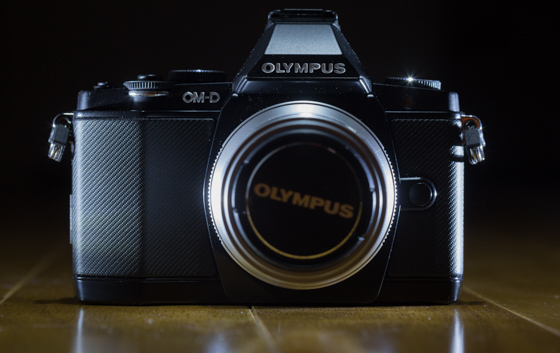
Olympus OMD EM5 vs Canon 5DmkIII – Size & Image Quality
My aching back yearns for a light camera system suitable for taking anywhere. I want a camera to take out to restaurants, out for a long walk, even out to a bar without drawing too much attention or taking up too much space or intimidating potential portrait subjects. Also, because I travel a good deal, I want to carry a small camera body and 2-3 extra lenses with me all day without any discomfort.
UPDATE: May 25th 2015 – I’ve written a follow up post to this review, which compares the OMD EM5 mkI vs the OMD EM5 mkII
Don’t get me wrong – I love the Canon 5dmkIII. It’s an amazing camera with outstanding image quality and I never hesitate to use it for wedding or portrait shoots that I’m being paid for. Also, the camera’s low light capabilities allow me to shoot in almost any low light situation. However, the thing is just too darn big and the lenses are too huge for casual purposes.
Size of Olympus OMD EM5 vs Canon 5DmkIII
– Body is 2.9x smaller by volume, 2.2x lighter
- Canon 5DmkIII size: 5.98 x 4.57 x 2.99″
- Olympus OMD EM5 size: 4.8 x 3.5 x 1.69″
- Canon 5DmkIII weight: 950g
- Olympus OMD EM5 weight: 425g
Micro 43rds Lenses vs Canon EF Lenses
– Equivalent Lens is 3.6x lighter, 2.8x smaller by volume
45mm Olympus Zuiko f/1.8 is a 90mm equivalent full frame lens
- Canon EF 85mm 1.8 weight: 15 oz. / 425g
- Olympus Zuiko 45mm 1.8 weight: 4.1 oz / 116g
- Canon EF 85mm 1.8 size: 5.4 x 4.3 x 4.3″
- Olympus Zuiko 45mm 1.8 size: 3.3 x 3.3 x 3.3″
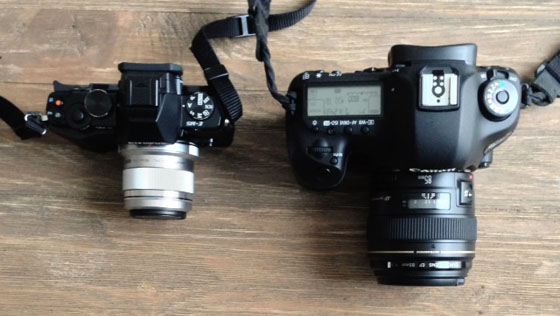
Recently, camera manufacturers launched several mirrorless interchangable lens systems that promise less of the bulk without compromising much on image quality. Most notable are the Sony NEX system, the Panasonic / Olympus Micro Four Thirds system, and to a lesser extent the Canon M series and Nikon 1 series.
About a year ago, I settled on the Olympus Micro Four Thirds system because of it’s small size, but most importantly the amazing lineup of extremely compact and fast \ bright, high quality lenses. While the NEX system promises a larger sensor and theoretically superior image quality, to me the biggest turnoffs to the NEX system are the lenses. NEX bodies may be razor thin, but the lenses are almost as large as APS-C DSLR lenses, slower (The Sony pancake lens has a maximum aperture of 2.8 while the Panasonic 20mm is a bright f/1.7), and lacking in the selection of lenses.
However, the image quality coming from the older Olympus sensors was a bit lacking (EPL-1 through EPL-3 and EP-1 through EP-3). I purchased an Olympus EPL-1 Pen camera a year ago and found the image quality to be great under ISO 400, but disappointing at higher ISOS (anything above ISO 800 was pretty unusable). Also, the resolution of these cameras topped out at 12 megapixels, which is on the lower edge of what I wanted.
I had almost written off this camera system when the Olympus OMD came out with excellent image quality up to ISO 3200 and the most advanced in camera stabilization of any camera to date. Many on the Internet were saying that Olympus had finally released a suitable DSLR replacement camera.
I recently purchased an OMD of my own and have found it worlds better than earlier Olympus Micro 43rds cameras. Below are sample images so that you can judge for yourself.
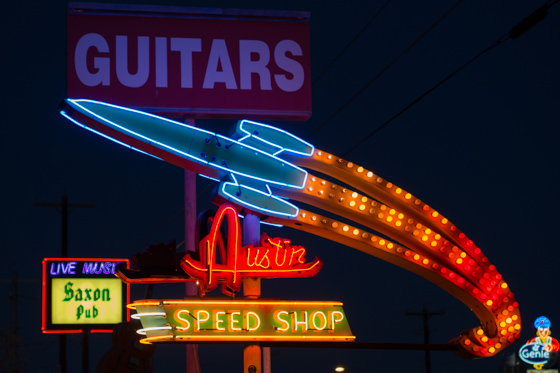
Olympus OMD EM5 with 45mm (90mm full frame equivalent) f/1.8 Zuiko Lens @ f/2 and ISO 400 (click to view a larger image)
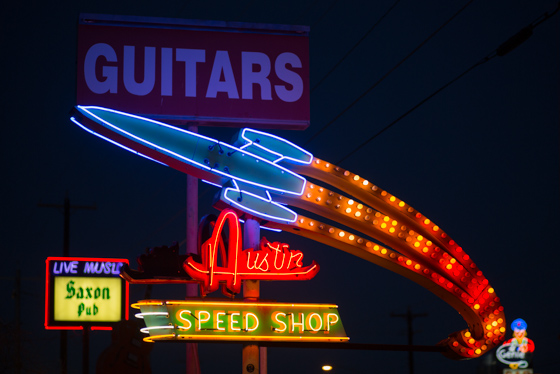
Canon 5DmkIII 85mm f/1.8 EF Lens @ f/2 and ISO 400 (click to view a larger image)
When you are shooting with similar glass on a 5DmkIII and a an OMD, it’s pretty safe to say that the image quality of the OMD and DSLR are very similar up to about ISO 1600. For web sized images, image quality is almost indistinguishable. The photos above were shot at nearly identical camera settings, and you’d be hard pressed to to tell me which image was shot with an EM5 and which one was shot with a Canon 5DmkIII. For those that love to peek pixels, I’ve resized both images to 3000 pixels on the long edge for a direct comparison.
The biggest difference and tell tale sign in my mind is the difference in depth of field between the two camera systems. Because the Micro Four Thirds sensor is half the size of a Canon 5dmkIII, images from the Olympus OMD will appear to have 2 stops more depth of field as a full frame image. So, the background is a bit more in focus in the top image. Even though it was shot at f/2 on the OMD, the corresponding focal plane would be as wide as the same image shot at f/4 on a 5DmkIII. This is most noticeable by looking at the bottom right corner of the image.
Overall, the OMD is amazingly light and a joy to work with. I’m still a little in disbelief how well such a small camera performs. The advanced image stabilization in body is a huge plus as well – I am pulling off images handheld that I normally would not be able to get with my DSLR. Also, the EVF and ability to use the tilting touchscreen on the back to take pictures is an awesome feature for shooting at odd angles. Also, the autofocus speed of the camera is also very impressive and almost on par with my 5DmkIII in most situations (except for tracking moving subjects).
The only downsides of the OMD camera system are the small button size and the fact that the AF does not track quite as well as a professional level DSLR. For casual users that want DSLR quality in a much smaller package though, this camera is a home run.
One more caveat is that to get DSLR like quality, you should upgrade from the kit lens. The 14-42 kit lens that came with my camera produces point and shoot like images (too much of the frame in focus for my liking) and a general lack of sharpness. However, the 20mm Panasonic f/1.7 prime and the 45mm f/1.8 lens are outstanding.
The following gallery of images are photos I took in the first week of owning the OMD.
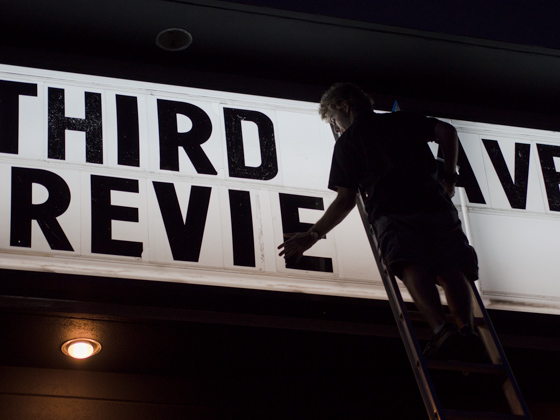
Marquee – Olympus OMD EM5 – 45mm Zuiko Lens – 1/1000 sec, f/1.8, ISO 200
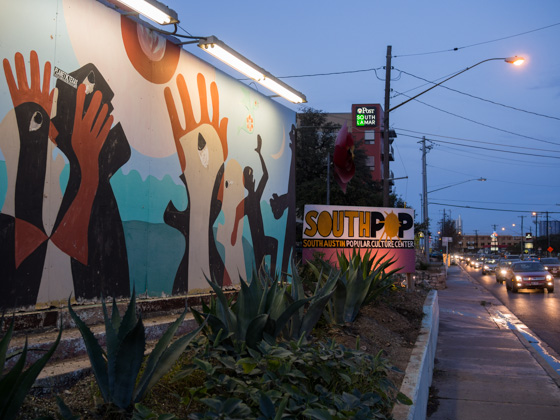
SouthPop – Olympus OMD EM5 – Panasonic 20mm Lens – 1/50 sec, f/3.2, ISO 250

Nicolai – Olympus OMD EM5 – Panasonic 20mm Lens – 1/13 sec, f/1.7, ISO 1600
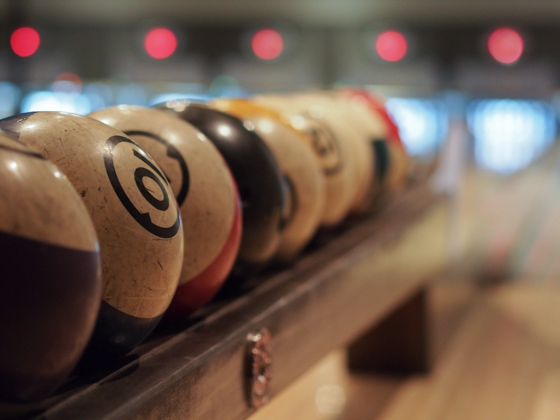
Bowling Balls – Olympus OMD EM5 – 45mm Zuiko Lens – 1/60 sec, f/1.8, ISO 1600
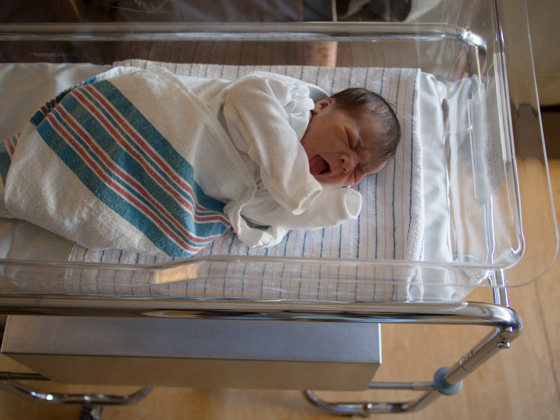
Lucian – Olympus OMD EM5 – Panasonic 20mm Lens – 1/60 sec, f/1.8, ISO 400
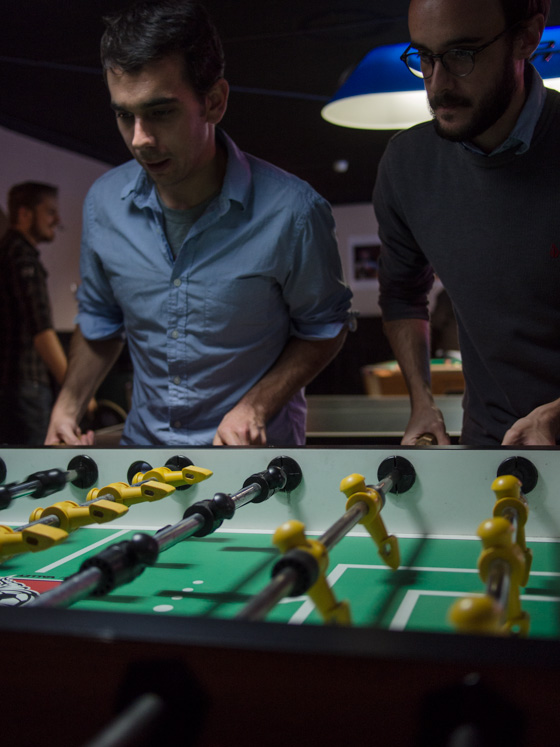
Dueling Photographers – Olympus EM5 – Panasonic 20mm Lens – 1/50 sec, f/1.8, ISO 640

Destruction in the Heart of Texas – Olympus 14-42 II kit Lens – 1/1600 sec, f/3.7, ISO 200
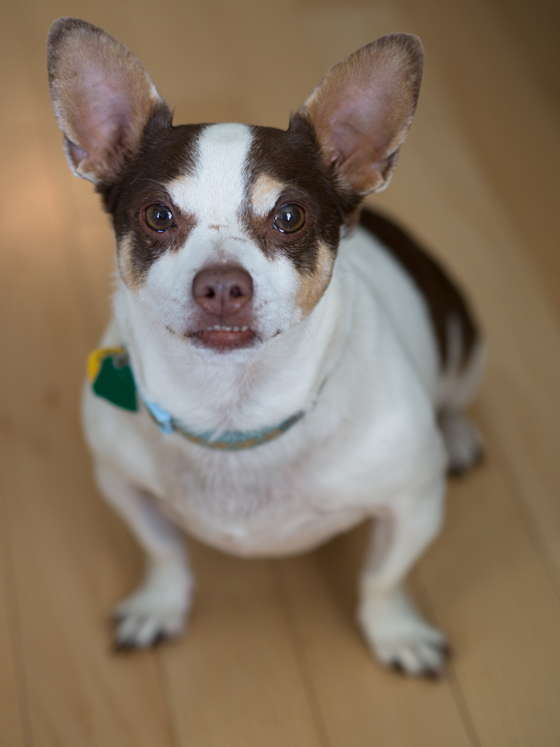
Bugsy – Olympus OMD EM5 – 45mm Zuiko Lens – 1/100 sec, f/1.8, ISO 250
Obligatory Cat Picture – Olympus OMD EM5 – 45mm Zuiko Lens – 1/100 sec, f/1.8, ISO 3200
(click on the image to view at full size)
In summary, the Olympus OMD EM5 makes for an amazing walkaround camera. In addition to being 3 times smaller than my 5DmkIII and half the weight, it has the benefit of providing in body image stabilization, a tilting touchscreen that allows you to take photos more easily, a surprisingly fast AF system, and a full range of options, bells and whistles. Unlike previous generations of m43 cameras, this one performs extremely well in low light situations up to ISO 3200.
I wouldn’t hesitate to recommend this camera. I have a feeling that my 5DmkIII sees much less use going forward, coming out only for the big jobs. For everything else casual, the OMD will be my go to system because of it’s small size and almost DSLR like image quality.

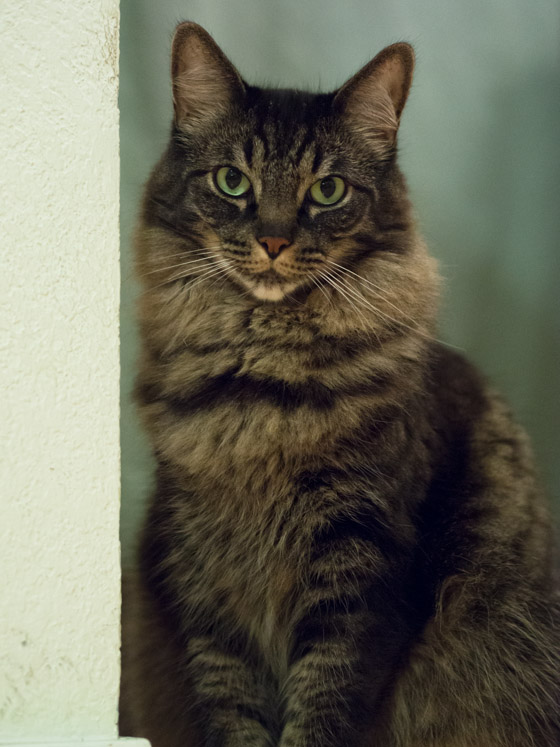
Jesse -
Very nice comparison. Makes me want to go get an EM5!
Wolfgang Lonien -
Thanks for the interesting comparison! Thinking about an E-PM2 or E-PL5 as a replacement for my E-PL1 when I see this…
Adriano -
Interesting ! I’m becoming a fan of Olympus system !
:)
Peter -
Thanks for the comments all. I am loving the EM-5 – it’s so light and versatile that I hardly ever take the 5D out anymore for travel stuff.
Wolfgang, the newest generation blows the E-PL1 out of the water. you’ll love it!
Mike Katona -
I really like my EM5 but when I want a real quality image I use my 5
D Mark II. No comparison.
Mike
Tom Mclalin -
I have to agree, i was in disbelief and at times still am after shooting with the em-5 for several months now the image quality amazes me. I also own a Nikon D800 and love it but am finding myself leaving it home most of the time in favor of the light package with top notch IQ.
I do hope the next version of the EM-5 will have a little bigger buttons and would really prefer a multi directional pad on the back instead of the four way buttons and if they would space the button layout to give a little more room i would be happy.
Mike -
Interesting the 5d images look warmer and more inviting but less interesting than the OMD images, there is a level of accuracy there that I find lacking in the bigger camera. I think I would prefer it to the Nikon D800 which I am not totally happy with. I suppose when it comes to high DOF landscapes or street scenes the OMD will show its real advantage apart from the better portability. Large DOF on Full frame is a struggle for me. Thanks
Terry breedlove -
I am seriously thinking about buying this camera and or the new EP5 which is supposed to available in a few weeks. I want to replace my aging nikon d2x mostly because of the weight and poor high ISO performance of that camera. However something always confuses me when I read these reviews on the Olympus OMD. The authors always rave about the image quality and focus etc but then say something Iike this quote from you. “I wouldn’t hesitate to recommend this camera. I have a feeling that my 5DmkIII sees much less use going forward, coming out only for the big jobs.” So my question is this. If the little Oly has such good image quality and performance, why isn’t it good enough to use professionally in say a wedding or whatever. Why the need to keep the big DSLR around for those “big jobs” ?
Peter -
@Terry – Hope this answers your question:
Since I wrote my review, I have carried the Olympus around much more often than the 5dmkIII. It’s so much lighter than my 5dmkIII and I can carry around my entire kit (5 lenses) in a bag that’s no bigger than a child’s lunch box.
While weight and pure enjoyment of shooting with the camera is a plus, Image quality in some situations is almost as good as the 5dmkIII, but not always. Autofocus performance and speed of operation are also an issue when shooting weddings.
The OMD is not great a tracking moving objects like a bride walking down the aisle in a dark church, or a football player running down a sideline, or a fashion model walking down the runway. You need a DSLR for that still.
Also, the 5dmkIII is probably still 1-2 stops better in low light. I won’t go above ISO 3200 on my OMD, but I know wedding photographers that will push ISO 12800 on their 5dmkIII.
Also, full frame gives you an amazingly shallow depth of field look that compliments certain types of photography such as wedding and some types of portrait work. If you have an f1.4 lens on a m43 camera, the depth of field is going to be similar to shooting a f2.8 lens on a FF camera at the same focal length (2 stops difference).
So, the short answer is that the OMD is an amazing and convenient camera for everyday casual situations. It gives you great quality images. It allows you to be more discrete. It won’t break your back.
However, a full frame DSLR is still better in other areas where performance is critical or clients want a certain look.
These differences aren’t necessarily a bad thing, they just are what they are. An OMD is better in some situations and a full frame DSLR is better in others.
Terry breedlove -
Peter thank you for the reply. That cleared it up for me. I get comfortable with my equipment and I tend to stick with it for years. In fact I stick it out way to long probably. switching to the little Oly is a big move for me. A camera I love and still have is my very old 35mm Nikon FE and the Oly EM5 reminds me of that camera. I like what I am reading about the Oly ep5 i just wish it had a EVF built in like the EM5.
Pingback: A tale of two pancake Lenses – Olympus OMD EM-5 + Panasonic 20mm f1.7 vs Canon EOS M EF-M 22mm | Peter Tsai Photography Blog
Suresh Guruprasad -
Thanks for the comparison. I am new to photography and currently use nikon coolpix. I usually use it indoors and low light to photograph kids in action. The p&s camera takes ages to focus and by the time I take the photo, I miss all the action. Hence I am considering buying a dslr. Will omd suffice my needs? What lens do I need? Before researching on m43s,I was considering canon eos 60d.
Peter -
Hi Suresh. The OMD is a step up from a point and shoot for sure. If you have a pretty bright lens (for example the 20mm 1.7) you should be able to take reasonably good photos indoors and in low light without a flash. The focus on the OMD should be faster than your point and shoot. The same is true of a 60D – you will need a nice, fast lens to take indoor pictures without a flash. I think the OMD and 60D are about equal in image quality.
Suresh Guruprasad -
Thanks Peter. I bought the omd and enjoying it. Got the 45mm f1.8 and is really good in low light without flash. I am not able to get 17mm or the 20mm f1.8 lens in India – will get it once it is launched here.
Terry breedlove -
So I bought the EM5 and shot a wedding with it. I love this little camera but the focus and tiny buttons etc can be an issue for wedding shooters. Hopefully the new EM-1 addresses those issues. Looks like it will. The image quality rocks. I love these files. The lenses rock. I have the 17 and 45 mm Oly lenses. If the EM-1 is what it appears to be then I will be a full time convert for sure.
Peter -
Hi Suresh and Terry, Glad to know my review helped influence your decision to get the camera, and happy to know that you are both enjoying it!
I’m still loving the camera – in fact last weekend I left the 5D at home and went to San Francisco only with the mirrorless cameras.
You both might be interested in checking out my photos @
http://www.flickr.com/photos/supertsai and http://www.flickr.com/photos/supertsai/sets/72157634037835601
Terry Breedlove -
I love those shots Peter. i might be in San Francisco at The end if the month and I can’t wait to shoot some street work with my little Oly. So far for most of my purposes the em5 has been great. Now looks like the EM 1 will be the perfect companion for my weddings and portrait work. Truly a dynamic duo. With the EM5 my 17 mm f 1.8 stays on camera about 99% of the time. Super quick focusing little bugger.
Pingback: Which Digital Camera is Right for Me? (2013) – Comparing Mirrorless, DSLR, Point & Shoot, and Camera Phones | Peter Tsai Photography Blog
Cobus -
Hi Peter, I have an OM-D E-M5 on order with three lenses, two zooms and the 45mm 1.8. I am replacing my aging Nikon D40 DSLR. I have been a keen photographer for almost 30 years but never made money out of photography. I am now considering trying to put pictures on stock photography sites and would like to know if in your opinion the E-M5 is suitable for stock photography? I think the answer will be yes, depending on what you shoot, but I would still like to hear your thoughts. Alternatively I could buy the new Canon 70D or a Fuji X-E1 or an X-Pro 1 at a push, but I really want a camera that I can carry with me all the time and as it is I never take my D40 with me, it’s too bulky for everyday carrying around.
Peter -
Cobus, I think that Micro 43rds is good enough for stock photography. I’ve had Getty images select a couple of my images taken with m43 and I’ve sold some images as well through other stock agencies. That said, if you are going for extremely narrow depth of field (which I believe is popular in certain types of stock photography), you are going to be disappointed.
Konrad -
I have recently changed from Canon to Olympus OMD EM1 & EM10. Much better value for money and the range of lenses is unbeattable. I use quite a number of 4/3 lenses of the HG series and they are very cheap to get compared to new prices. You just have to be patient. The small sensor size should not really be a problem. If you consider how good even smartphone cameras have become there should still be plenty of headroom left in the 4/3 sensor and besides does anybody really need 50MP size photos except the most demanding of professionals. Its still the photographer who is responsible for a good shot.
Cheers Konrad
Pingback: OMD EM5 MkII Review + Comparison with the Original OMD EM5 | Peter Tsai Photography Blog
Pingback: Best Street Photography Camera 2013 - London Street Photo
Marlon -
Anymore, we’ve seen a gravitation toward small and compact, in the realm of photography. Myself, included. I had both a Canon G10 and EOS 50D. Since the G10 also shot RAW, I predominantly only carried it around. If you know what you are doing in the metering department, it can shoot SLR quality. I even pulled off slow exposure timed waterfall shots at SLR quality, given, it’s built in ND filter. I have an EM5 on order to replace my bulky EOS with…especially, since it outperforms it in almost every way.